Memory Scaling on Core i7 - Is DDR3-1066 Really the Best Choice?
by Gary Key on June 24, 2009 9:00 AM EST- Posted in
- Memory
Even though our DDR3-2000 kits were not cooperating with us, we were able to run a few benchmarks to determine which memory setting would be ideal at our 3.8GHz (19x200) processor speed. We arrived at this clock speed, as it is a free overclock with only VTT needing to be increased to handle our particular memory speeds and timings. We will take a look at other overclocked speeds and memory settings in the near future.
Everest 5.02.1765
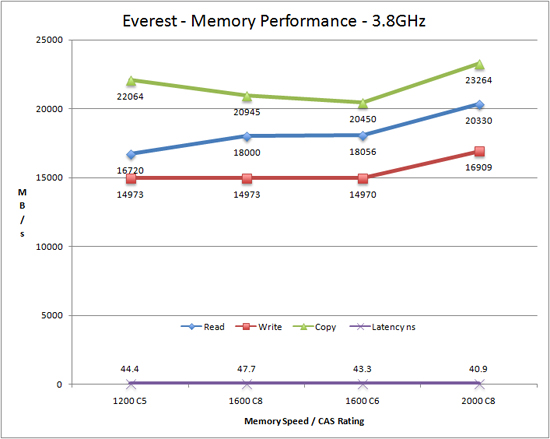
Going from 1250 C5 to 2000 C8 nets a 5% improvement in memory reads, 21% in writes, 13% in copy speeds, and 8% in latency. Interestingly enough, 1200 C5 provides excellent results compared to 1600 C8 and our application benchmarks reflect this fact.
AutoCAD 2009 x64
We utilize AutoCAD 2009 x64 and the Cadalyst Labs benchmark.

Just like our stock clock results, the 3D scores are respond better to the slower memory speeds. Once again, decreased latencies and greater bandwidth generally resulted in improved 2D and CPU scores.
3ds Max 2009 x64
We utilize a rather large mental ray image and track the time it takes to render it.
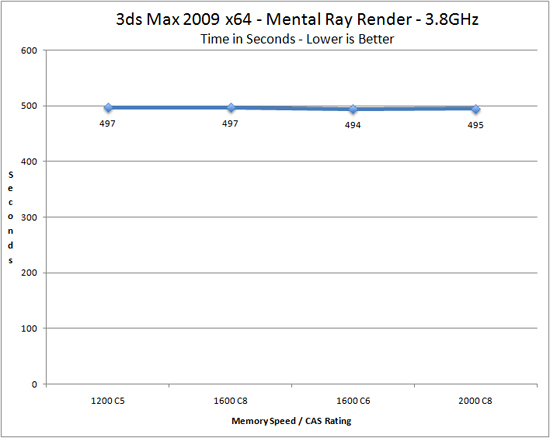
In our stock test we measured a 3% increase in performance (19 second reduction) moving from DDR3-1066 C7 to DDR3-1600 C6. In our overclock test the 2 second difference between 1200 C5 and 2000 C7 is minimal as clock speed is king at this point.
LightWave 3D 9.6 x64
We time the rendering of a single frame from an office building animation. The time to render the full scene is approximately four and a half hours.
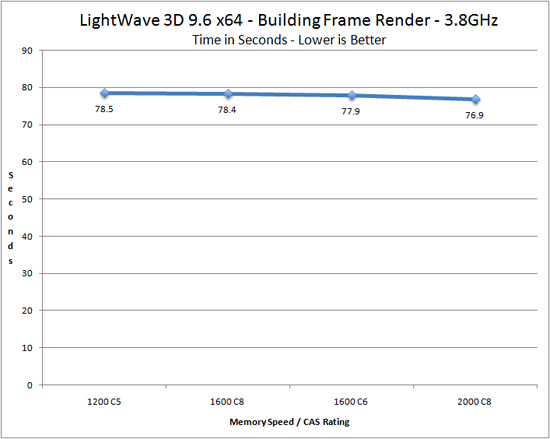
The stock test revealed a 6% advantage for DDR3-1866 C7 over DDR3-1066 C7. The overclock test indicates a 2% advantage for 2000 C8 compared to 1200 C5.
WinRAR 3.9b3 x64
This benchmark compresses our AT workload consisting of a main folder that contains 954MB of files in 15 subfolders. The result is a compressed file approximately 829MB in size.
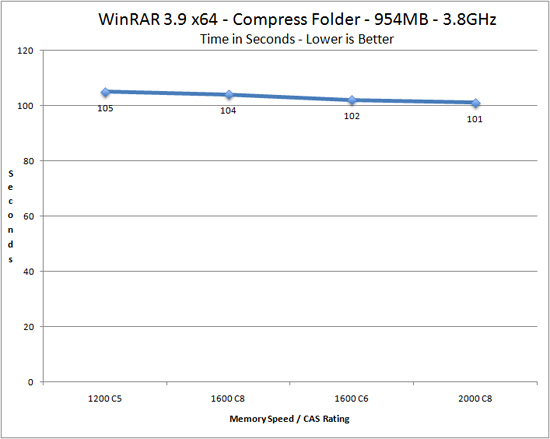
In our stock tests, going from DDR3-1066 C7 to DDR3-1866 C7 resulted in a 20% decrease in processing time. With our processor overclocked to 3.8GHz, this benchmark provides a 4% increase in performance when moving from 1200 C5 to 2000 C8.
MainConcept Reference 1.61
We set our profile to iPOD HQ NTSC and then transcode a 651MB 1080P file to a iPOD friendly 34.7MB file.
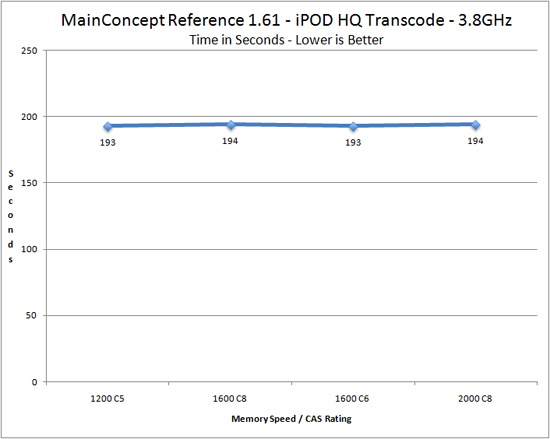
Our stock test showed a 3% improvement in performance when scaling from DDR3-1066 to DDR3-1866. Overclocking our system resulted in a .05% variation in the score with our two low latency settings performing ever so slightly better.










47 Comments
View All Comments
ilkhan - Wednesday, June 24, 2009 - link
running a small cross section of the tests in dual channel mode would be the improvement I can see. Awesome article.Gary Key - Wednesday, June 24, 2009 - link
We will have dual channel results in the 3GB, 4GB, 6GB, 12GB article in a couple of weeks. Right now, you are not giving up that much if any at all in most of these apps with a dual channel 4GB/8GB setup.The0ne - Wednesday, June 24, 2009 - link
The use of percentages and the comments made for them is vastly different than comments made for video cards. A 14% gain in minimal FPS isn’t much, especially for Dawn of War II. To state the game is a “stutter fest” from a low of 12FPS to “smooth” of a high 17FPS is really exaggerating the picture. 17FPS is still a “stutter fest.”From the data collected it really can be said, much like video card reviews is, that if you have the money and want the best then buy the faster memory, otherwise it is a waste of your hard earn money. My point of posting this comment is that the objectivity should not be any different when talking about FPS gains. Here it appears to sound more pleasing even though the numbers don’t show much gain at all.
GourdFreeMan - Thursday, June 25, 2009 - link
For nearly all human beings the perception of motion as opposed to a progression of still frames lies in the 8-20 fps range. It is not beyond the realm of possibility that Gary's perception of stutter is from crossing this threshold at least momentarily while playing Dawn of War II. Of course, you could probably more cheaply improve your minimum frame rate by buying a better video card than faster RAM unless the game really is (CPU) memory bound.SiliconDoc - Sunday, July 5, 2009 - link
I kind of thought the opposite of the two prior comment (except I agree it may have been exagerrated to go with smooth as silk)- it seems to me that 2%-5%-7%-14% framerate gains are usually considered quite impressive and quite a win in videocard comparisons, and especially in minimum framerate areas, that would be quite nice.I understand it's a different review person, hence perspective and emphasis to a large degree, but it impressed me in the sense that those sized percentages are the end all and be all in video card comparisons - oh golly the declatory winners with that kind of spread based on just videocard performance... so discounting it here - no way.
So, except for the statement that overclocking the cpu is as much or more a gain and overpowers and negates ram timings to a degree (if I caught that latter part intent correctly in the article), I'd have to say the ram advantage is very important to the hardcore videocard shoppers - it can really add quite an edge - as much as a videocard / head to head choice based on benches. Maybe enough to wait for higher clocked ram prices to drop, or score that great deal on overclockable ram.
I enjoyed the article mainly because of those FPS benches shown.
fishbits - Wednesday, June 24, 2009 - link
"Of course, those that are doing all of these activities and more will benefit from purchasing fast low-latency memory and we even suggest getting 12GB while you are at it."How much of a performance hit (if any) is there typically in populating 6 banks on an i7 system versus 3?
bh192012 - Wednesday, June 24, 2009 - link
I'm not sure I understand the conclusion. You recommend DDR3-1333 C6 for people who want a little more speed, but it seems to me that your data shows that DDR3-1600 C9 is faster and cheaper?Example:
1066 c5 / min fps H.A.W.X. 80/50 = 1.60$ per frame
1333 c6 / min fps H.A.W.X. 125/52 = 2.40$ per frame
1600 c9 / min fps H.A.W.X. 85/54 = 1.58$ per frame (winner)
1600 c6 / min fps H.A.W.X. 175/56 = 3.13$ per frame
QChronoD - Wednesday, June 24, 2009 - link
I would have to assume that you are doing your calculations on the Min frame rate?Personally, I would look at that and see that they are about equal at the minimum, but 1333c6 is almost 50% faster on average!
I'd suggest redoing your $/fps with the average rates.
bh192012 - Wednesday, June 24, 2009 - link
Where is 1333 c6 50% faster than 1600 c9? I think you have confused the price chart with a benchmark or something. Also, min FPS are more important.Affectionate-Bed-980 - Wednesday, June 24, 2009 - link
Uhh obviously no one read this article really because Page 11 is supposed to be about choosing a kit, yet it has 3D rendering benchmarks which should be on page 12.... Yeah..